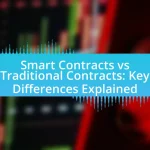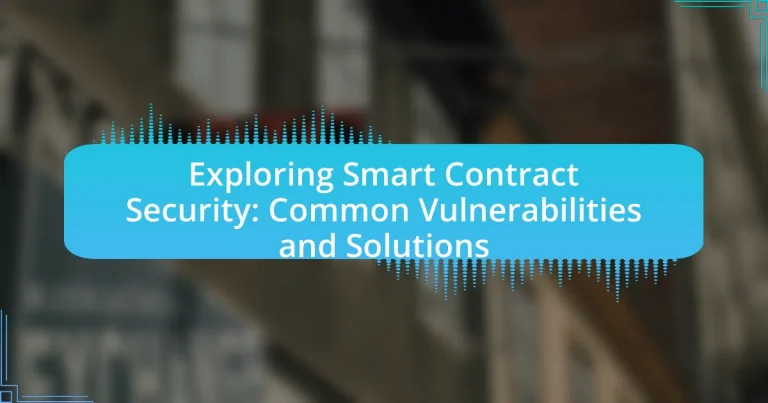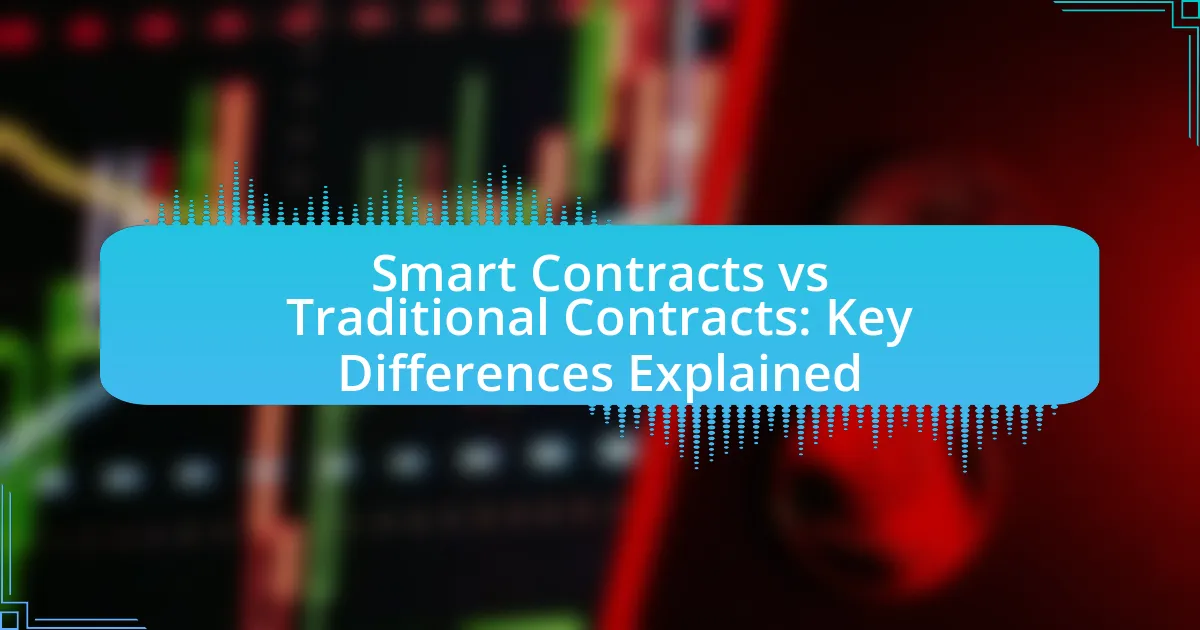Smart contracts are self-executing agreements coded on blockchain technology, automating and enforcing terms without intermediaries, which enhances efficiency and reduces costs. This article explores the significance of smart contracts, their operational mechanics within blockchain, and the key components that ensure their functionality. It also addresses common vulnerabilities, such as reentrancy and integer overflow, that can lead to financial losses, and discusses solutions for enhancing security, including formal verification and code audits. By examining best practices and available tools for security analysis, the article aims to provide a comprehensive understanding of smart contract security and the importance of addressing vulnerabilities to maintain trust in blockchain applications.
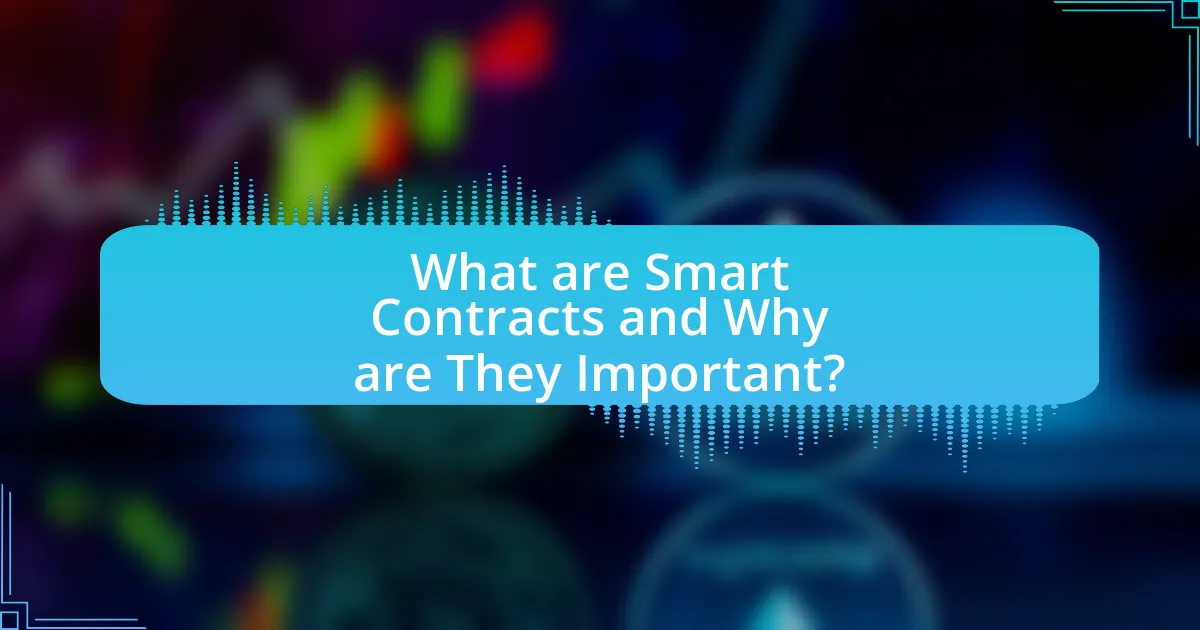
What are Smart Contracts and Why are They Important?
Smart contracts are self-executing contracts with the terms of the agreement directly written into code, operating on blockchain technology. They are important because they automate and enforce contractual agreements without the need for intermediaries, reducing costs and increasing efficiency. According to a report by the World Economic Forum, smart contracts could account for over $3 trillion in business value by 2030, highlighting their potential to transform various industries by enhancing transparency and security in transactions.
How do Smart Contracts function in blockchain technology?
Smart contracts function in blockchain technology by executing predefined agreements automatically when specific conditions are met. These self-executing contracts are coded into the blockchain, ensuring that once deployed, they cannot be altered, which enhances security and trust. For instance, Ethereum, a leading blockchain platform, allows developers to create smart contracts using its programming language, Solidity. This functionality enables various applications, such as decentralized finance (DeFi) and automated transactions, to operate without intermediaries. The immutability of blockchain records further guarantees that the terms of the contract are transparent and verifiable, reducing the risk of fraud and disputes.
What are the key components of a Smart Contract?
The key components of a Smart Contract include code, execution environment, and state. The code defines the rules and conditions of the contract, typically written in programming languages like Solidity for Ethereum. The execution environment, such as a blockchain platform, facilitates the deployment and execution of the contract, ensuring that it operates in a decentralized manner. The state represents the current status of the contract, including variables and data that can change over time as the contract is executed. These components work together to ensure that Smart Contracts function securely and reliably within their intended framework.
How do Smart Contracts execute automatically?
Smart contracts execute automatically through self-executing code stored on a blockchain, which triggers actions when predefined conditions are met. This automation relies on the blockchain’s decentralized nature, ensuring that once the contract is deployed, it operates without the need for intermediaries. The execution is governed by the consensus rules of the blockchain network, which validate and record the outcomes of the contract’s conditions being fulfilled. For instance, Ethereum smart contracts utilize the Ethereum Virtual Machine (EVM) to process transactions and enforce the contract logic, ensuring that all parties adhere to the agreed terms without manual intervention.
What are the advantages of using Smart Contracts?
Smart contracts offer several advantages, including automation, transparency, and security. Automation reduces the need for intermediaries, streamlining processes and minimizing human error. Transparency ensures that all parties can view the contract terms, fostering trust and accountability. Security is enhanced through cryptographic techniques, making smart contracts resistant to tampering and fraud. According to a report by the World Economic Forum, smart contracts can potentially save businesses up to $3 trillion annually by increasing efficiency and reducing transaction costs.
How do Smart Contracts enhance transparency?
Smart contracts enhance transparency by automating and recording transactions on a blockchain, which is a decentralized and immutable ledger. This means that once a smart contract is deployed, all parties involved can view the contract’s terms and the transaction history, ensuring that no alterations can be made without consensus. For instance, Ethereum smart contracts allow users to verify the execution of agreements without relying on intermediaries, thereby reducing the risk of fraud and increasing trust among participants. The transparency is further supported by the fact that all transactions are publicly accessible, allowing for independent verification and auditability, which is a fundamental characteristic of blockchain technology.
What cost savings do Smart Contracts provide?
Smart contracts provide significant cost savings by automating processes and eliminating intermediaries. By executing transactions automatically when predefined conditions are met, smart contracts reduce the need for manual oversight and administrative costs associated with traditional contract management. According to a study by the World Economic Forum, smart contracts could save businesses up to $3 trillion annually by streamlining operations and reducing transaction costs. Additionally, the use of blockchain technology ensures transparency and security, further minimizing the risk of fraud and associated costs.
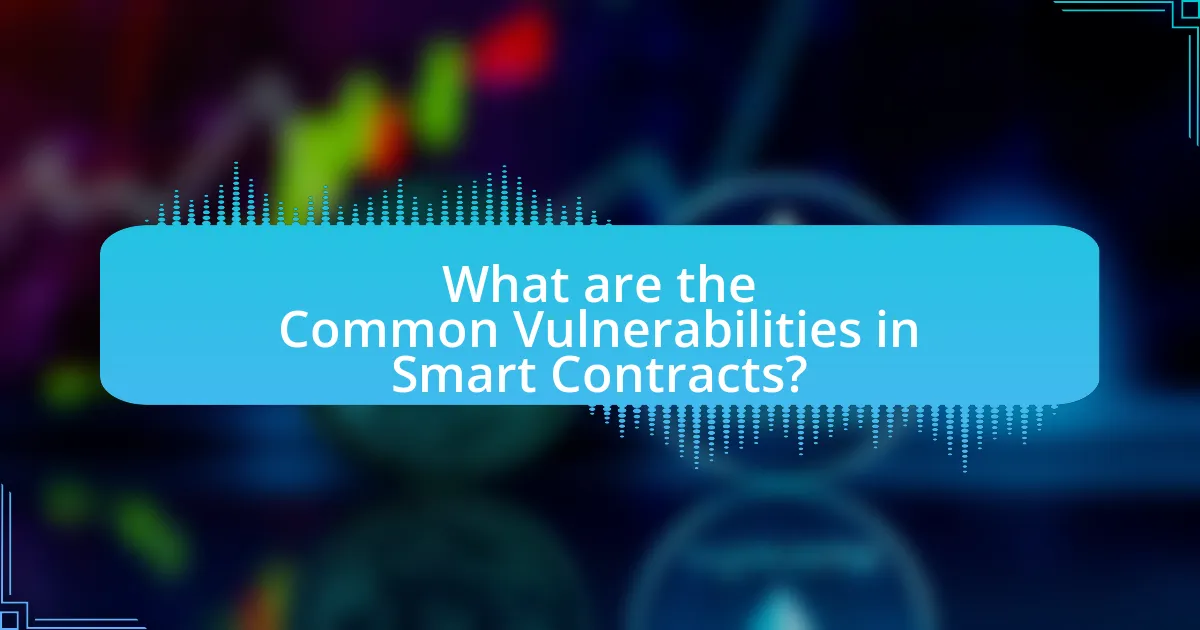
What are the Common Vulnerabilities in Smart Contracts?
Common vulnerabilities in smart contracts include reentrancy, integer overflow and underflow, gas limit and loops, timestamp dependence, and improper access control. Reentrancy occurs when a contract calls another contract and allows the second contract to call back into the first contract before the first execution is complete, leading to potential exploitation. Integer overflow and underflow happen when arithmetic operations exceed the maximum or minimum limits of data types, causing unexpected behavior. Gas limit and loops can lead to transactions failing if they exceed the gas limit, particularly in contracts with unbounded loops. Timestamp dependence arises when contracts rely on block timestamps for critical logic, which can be manipulated by miners. Improper access control allows unauthorized users to execute functions that should be restricted, leading to potential security breaches. These vulnerabilities have been documented in various incidents, such as the DAO hack in 2016, which exploited reentrancy, resulting in a loss of $60 million worth of Ether.
What are the most prevalent types of vulnerabilities?
The most prevalent types of vulnerabilities in smart contracts include reentrancy, integer overflow and underflow, gas limit and loops, timestamp dependence, and improper access control. Reentrancy vulnerabilities allow attackers to exploit the contract by repeatedly calling a function before the previous execution is complete, as demonstrated in the DAO hack where an attacker drained funds. Integer overflow and underflow occur when arithmetic operations exceed the maximum or minimum limits of data types, leading to unexpected behavior, which was notably exploited in the Ethereum Classic hack. Gas limit and loops can cause contracts to fail if they exceed the gas limit during execution, while timestamp dependence can be manipulated by miners to influence contract outcomes. Lastly, improper access control can lead to unauthorized actions being performed, as seen in various exploits where functions were executed by unauthorized users.
How does reentrancy affect Smart Contracts?
Reentrancy affects smart contracts by allowing an attacker to exploit a function call that can be invoked multiple times before the initial execution completes. This vulnerability can lead to unauthorized access to funds or manipulation of contract state, as seen in the infamous DAO hack in 2016, where an attacker drained approximately $60 million worth of Ether by repeatedly calling a withdrawal function before the contract could update its balance. The risk of reentrancy arises when a contract calls an external contract, which can then call back into the original contract, potentially leading to unexpected behaviors and financial loss.
What is integer overflow and underflow in Smart Contracts?
Integer overflow and underflow in smart contracts refer to errors that occur when arithmetic operations exceed the maximum or minimum limits of integer data types. Specifically, integer overflow happens when a calculation results in a value greater than the maximum representable integer, causing it to wrap around to the minimum value. Conversely, integer underflow occurs when a calculation results in a value less than the minimum representable integer, causing it to wrap around to the maximum value. These vulnerabilities can lead to significant security issues, such as unauthorized access to funds or manipulation of contract logic, as evidenced by incidents like the DAO hack in 2016, where an integer overflow was exploited to drain funds.
Why is it crucial to address these vulnerabilities?
Addressing vulnerabilities in smart contracts is crucial to prevent financial losses and maintain trust in blockchain technology. Smart contracts, once deployed, are immutable and can be exploited if vulnerabilities are not mitigated, leading to significant financial theft; for instance, the DAO hack in 2016 resulted in a loss of $60 million due to a vulnerability. Furthermore, addressing these vulnerabilities enhances the overall security of decentralized applications, ensuring user confidence and promoting wider adoption of blockchain solutions.
What are the potential consequences of ignoring vulnerabilities?
Ignoring vulnerabilities in smart contracts can lead to significant financial losses, security breaches, and damage to reputation. For instance, the DAO hack in 2016 resulted in the loss of $60 million due to an exploited vulnerability, highlighting the real-world impact of neglecting security flaws. Additionally, ignoring vulnerabilities can result in legal repercussions, as affected parties may seek restitution for losses incurred. The cumulative effect of these consequences can undermine trust in blockchain technology and deter future investments.
How can vulnerabilities lead to financial losses?
Vulnerabilities in smart contracts can lead to financial losses by allowing malicious actors to exploit weaknesses in the code, resulting in unauthorized access to funds or manipulation of contract terms. For instance, the DAO hack in 2016 exploited a vulnerability in the Ethereum smart contract, leading to a loss of approximately $60 million worth of Ether. Such incidents demonstrate that poorly designed or audited smart contracts can be easily compromised, leading to significant financial repercussions for users and investors.
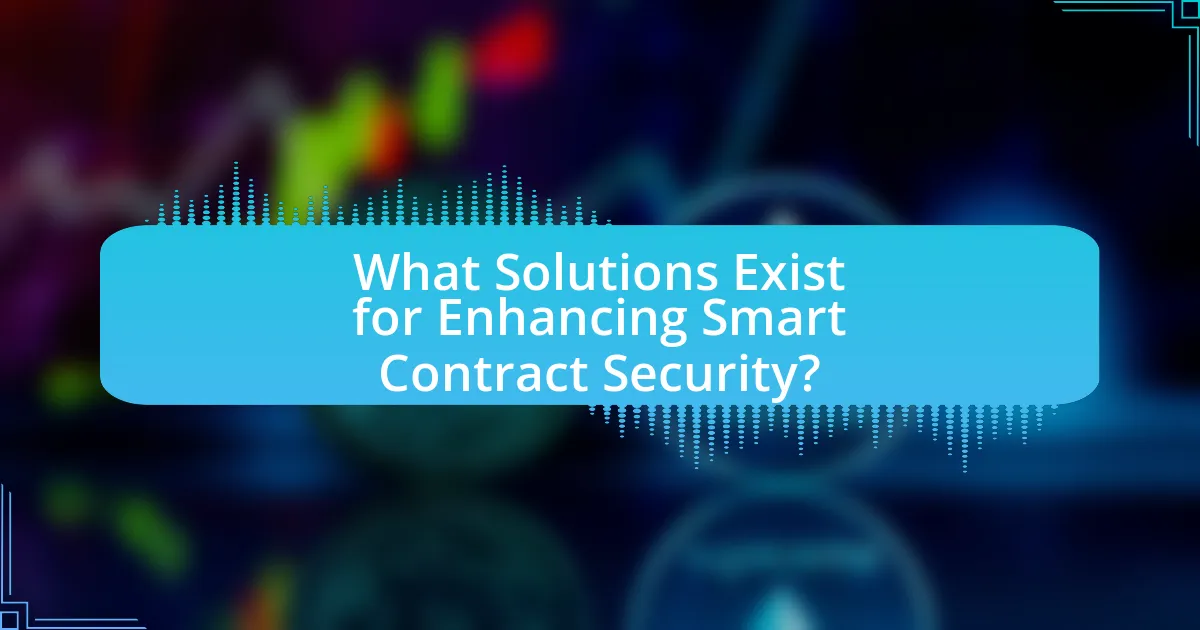
What Solutions Exist for Enhancing Smart Contract Security?
Solutions for enhancing smart contract security include formal verification, code audits, and the use of security-focused programming languages. Formal verification mathematically proves the correctness of smart contracts, reducing the likelihood of vulnerabilities; for instance, tools like Coq and Isabelle are used for this purpose. Code audits involve thorough reviews by security experts to identify potential flaws, which has been shown to significantly decrease the risk of exploits, as evidenced by successful audits conducted by firms like Trail of Bits. Additionally, programming languages designed with security in mind, such as Solidity and Vyper, incorporate features that help prevent common vulnerabilities, thereby enhancing overall security.
What best practices can developers follow to secure Smart Contracts?
Developers can secure smart contracts by following best practices such as conducting thorough code audits, utilizing formal verification methods, and implementing proper access controls. Code audits help identify vulnerabilities before deployment, as evidenced by the fact that many high-profile hacks stem from overlooked coding errors. Formal verification mathematically proves the correctness of algorithms, reducing the risk of logical flaws; studies show that this method can significantly enhance contract reliability. Additionally, implementing access controls ensures that only authorized users can execute sensitive functions, which is crucial for preventing unauthorized actions. These practices collectively contribute to a more secure smart contract environment.
How can thorough testing and auditing improve security?
Thorough testing and auditing enhance security by identifying vulnerabilities before they can be exploited. This proactive approach allows developers to address weaknesses in smart contracts, reducing the risk of attacks such as reentrancy or overflow errors. For instance, a study by ConsenSys Diligence found that 70% of smart contracts contain vulnerabilities, highlighting the necessity of rigorous testing and auditing processes to mitigate potential threats. By employing automated tools and manual reviews, organizations can ensure that their smart contracts are robust and secure, ultimately protecting user assets and maintaining trust in blockchain technology.
What role do formal verification methods play in Smart Contract security?
Formal verification methods play a critical role in enhancing Smart Contract security by mathematically proving the correctness of contract code against its specifications. These methods help identify vulnerabilities and ensure that the contract behaves as intended under all possible conditions, thereby reducing the risk of exploits. For instance, a study by Bartoletti et al. (2017) demonstrated that formal verification can uncover logical errors that traditional testing methods might miss, leading to more robust Smart Contracts. By employing formal verification, developers can significantly mitigate risks associated with security flaws, ensuring greater trust and reliability in blockchain applications.
How can developers stay updated on security threats?
Developers can stay updated on security threats by regularly following reputable cybersecurity news sources, subscribing to threat intelligence feeds, and participating in security-focused forums and communities. For instance, platforms like the Open Web Application Security Project (OWASP) provide valuable resources and updates on vulnerabilities. Additionally, attending industry conferences and webinars can enhance awareness of emerging threats and best practices. According to a 2022 report by Cybersecurity Ventures, organizations that actively engage in continuous learning and threat monitoring reduce their risk of breaches by up to 50%.
What resources are available for ongoing education in Smart Contract security?
Ongoing education in Smart Contract security is supported by various resources, including online courses, webinars, and community forums. Platforms like Coursera and Udemy offer specialized courses on blockchain and Smart Contract security, while organizations such as the Blockchain Security Alliance provide webinars and workshops focused on current vulnerabilities and best practices. Additionally, community forums like Ethereum Stack Exchange and Reddit’s r/ethdev allow practitioners to discuss security issues and share knowledge. These resources are essential for staying updated on the evolving landscape of Smart Contract security.
How can community engagement help in identifying vulnerabilities?
Community engagement can significantly aid in identifying vulnerabilities by fostering collaboration and knowledge sharing among stakeholders. Engaged communities can provide diverse perspectives and insights that highlight potential weaknesses in smart contracts, which may not be apparent to developers alone. For instance, community-driven audits and bug bounty programs have proven effective; platforms like GitHub and HackerOne have facilitated the discovery of vulnerabilities through collective scrutiny, leading to the identification of critical flaws before exploitation. This collaborative approach not only enhances security but also builds trust within the ecosystem, as evidenced by the increased number of reported vulnerabilities in projects that actively involve their communities in security discussions and initiatives.
What are the practical steps for securing Smart Contracts?
To secure smart contracts, developers should implement several practical steps: conduct thorough code audits, utilize formal verification methods, and adopt best practices in coding. Code audits involve reviewing the smart contract code for vulnerabilities, which can prevent exploits; for instance, the DAO hack in 2016 highlighted the importance of this step. Formal verification mathematically proves the correctness of the code against its specifications, ensuring that the contract behaves as intended. Additionally, following best practices, such as using established libraries and frameworks, can mitigate common vulnerabilities like reentrancy and overflow errors. These steps collectively enhance the security posture of smart contracts, reducing the risk of financial loss and reputational damage.
How can developers implement security audits effectively?
Developers can implement security audits effectively by establishing a structured audit process that includes automated tools, manual code reviews, and adherence to best practices. This process begins with the use of automated security scanning tools to identify common vulnerabilities such as reentrancy and overflow errors, which are prevalent in smart contracts. Following the automated analysis, developers should conduct thorough manual code reviews to assess the logic and architecture of the smart contract, ensuring that all potential attack vectors are considered.
Additionally, developers should engage third-party security firms to perform independent audits, as external perspectives can uncover issues that internal teams may overlook. According to a report by ConsenSys Diligence, smart contracts that undergo multiple rounds of audits are significantly less likely to be exploited, highlighting the importance of comprehensive auditing. By combining automated tools, manual reviews, and third-party audits, developers can create a robust security audit framework that minimizes risks associated with smart contract vulnerabilities.
What tools are available for Smart Contract security analysis?
Tools available for Smart Contract security analysis include MythX, Slither, and Oyente. MythX is a comprehensive security analysis platform that provides automated vulnerability detection for Ethereum smart contracts. Slither is a static analysis tool that identifies vulnerabilities and provides detailed information about the code structure. Oyente analyzes Ethereum smart contracts for potential security issues by simulating their execution. These tools are widely recognized in the blockchain community for their effectiveness in identifying vulnerabilities, thereby enhancing the security of smart contracts.

